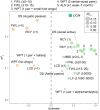Recovery and Degradation Drive Changes in the Dispersal Capacity of Stream Macroinvertebrate Communities
- PMID: 39868825
- PMCID: PMC11771701
- DOI: 10.1111/gcb.70054
Recovery and Degradation Drive Changes in the Dispersal Capacity of Stream Macroinvertebrate Communities
Erratum in
-
Correction to "Recovery and Degradation Drive Changes in the Dispersal Capacity of Stream Macroinvertebrate Communities".Glob Chang Biol. 2025 Oct;31(10):e70538. doi: 10.1111/gcb.70538. Glob Chang Biol. 2025. PMID: 41041825 No abstract available.
Abstract
Freshwater ecosystems face significant threats, including pollution, habitat loss, invasive species, and climate change. To address these challenges, management strategies and restoration efforts have been broadly implemented. Across Europe, such efforts have resulted in overall improvements in freshwater biodiversity, but recovery has stalled or failed to occur in many localities, which may be partly caused by the limited dispersal capacity of many species. Here, we used a comprehensive dataset comprising 1327 time series of freshwater macroinvertebrate communities ranging from 1968 to 2021 across 23 European countries to investigate whether dispersal capacity changes with the ecological quality of riverine systems. Sites experiencing improvements in ecological quality exhibited a net gain in species and tended to have macroinvertebrate communities containing species with stronger dispersal capacity (e.g., active aquatic and aerial dispersers, species with frequent propensity to drift, and insects with larger wings). In contrast, sites experiencing degradation of ecological quality exhibited a net loss of species and a reduction in the proportion of strong dispersers. However, this response varied extensively among countries and local sites, with some improving sites exhibiting no parallel gains in macroinvertebrates with higher dispersal capacity. Dispersal capacity of the local species pool can affect the success of freshwater ecosystem restoration projects. Management strategies should focus on enhancing landscape connectivity to create accessible "source" areas and refugia for sensitive taxa, especially as climate change reshapes habitat suitability. Additionally, biodiversity initiatives must incorporate adaptive decision-making approaches that account for the site-specific responses of macroinvertebrate communities to changes in ecological quality.
Los ecosistemas de agua dulce se enfrentan a importantes amenazas, como la contaminación, la pérdida de hábitats, las especies invasoras y el cambio climático. Para hacer frente a estos retos, se han aplicado ampliamente estrategias de gestión y esfuerzos de restauración. En toda Europa, estos esfuerzos han dado lugar a mejoras generales de la biodiversidad en ecosistemas de agua dulce, pero la recuperación se ha estancado o no se ha producido en muchas localidades, lo que puede deberse en parte a la limitada capacidad de dispersión de algunas especies. En este trabajo, hemos utilizado un amplio conjunto de datos que comprende 1327 series temporales de comunidades de macroinvertebrados de agua dulce desde 1968 hasta 2021 en 23 países europeos para investigar si la capacidad de dispersión de dichas comunidades cambia con la calidad ecológica de los sistemas fluviales. Los lugares con una mejor calidad ecológica experimentaron una ganancia neta de especies y tendieron a tener comunidades de macroinvertebrados que contenían especies con mayor capacidad de dispersión (por ejemplo, dispersores acuáticos y aéreos activos, insectos con alas más grandes). Por el contrario, los lugares más degradados experimentaron una pérdida neta de especies y mostraron una reducción de la proporción de grandes dispersores. Sin embargo, esta respuesta varió ampliamente entre países y lugares, y algunos sitios que mostraron una mejora de la calidad ecológica a lo largo del tiempo no presentaron ganancias paralelas de macroinvertebrados con mayor capacidad de dispersión. La capacidad de dispersión de las especies locales puede afectar al éxito de los proyectos de restauración de ecosistemas de agua dulce. Las estrategias de gestión deben centrarse en mejorar la conectividad del paisaje para crear zonas «fuente» accesibles y refugios para especies sensibles, especialmente a medida que el cambio climático modifica la idoneidad del hábitat. Además, las iniciativas de restauración de la biodiversidad deben incorporar enfoques de toma de decisiones adaptativos que tengan en cuenta las respuestas específicas de las comunidades de macroinvertebrados a los cambios en la calidad ecológica.
Keywords: Europe; dispersal capacity metric; ecological quality ratio; freshwater macroinvertebrates; restoration; river; time series; traits.
Global Change Biology© 2025 The Author(s). Global Change Biology published by John Wiley & Sons Ltd.
Conflict of interest statement
The authors declare no conflicts of interest.
Figures





References
-
- Barton, K. 2023. “Package ‘MuMIn’.” Version 1.47.5.
-
- Bates, D. , Mächler M., Bolker B., and Walker S.. 2015. “Fitting Linear Mixed‐Effects Models Using lme4.” Journal of Statistical Software 67: 1–48. 10.18637/jss.v067.i01. - DOI
-
- Baur, B. 2014. “Dispersal‐Limited Species—A Challenge for Ecological Restoration.” Basic and Applied Ecology 15, no. 7: 559–564. 10.1016/j.baae.2014.06.004. - DOI
MeSH terms
Grants and funding
LinkOut - more resources
Full Text Sources

